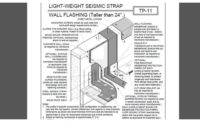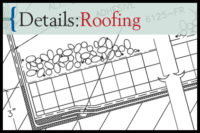Prior to the installation of the parapet coping, a metal flashing material shall be adhered to the structural wall. The metal flashing shall lap the parapet wall. The top of the metal flashing shall be terminated with a counterflashing that is either surface mounted or set in a reglet.
The metal coping is then applied over the completed wall flashing and secured in accordance with local wind zone requirements. (Perimeter metal coping materials must be in compliance with ANSI/SPRI ES-1 requirements.) A prefabricated sheet metal saddle flashing is applied at the junction of the structural wall and parapet wall to terminate exposed openings. The saddle flashing shall be set in two continuous beads of sealant.
A bead of continuous sealant shall be applied at the top of the counterflashing and the seams of the sheet metal saddle flashing.
Notes
1. Dimensions shown are recommended minimums and are intended to be approximate to allow for reasonable tolerances due to field conditions.2. Attach top of membrane wall flashing approximately 6" O.C.
3. See Appendix A for gauge or thickness guide for sheet metal flashing.
4. Continuous cleats are recommended when flashing face dimension exceeds 3 inches and in areas deemed high wind zone as categorized by local building code.
5. Certain components as depicted in these details may not be provided by the roofing contractor.
6. Pre-flashing the coping-to-wall termination with membrane flashing (e.g. with self-adhering membrane) is suggested prior to installation of sheet metal saddle flashing.

Coping-to-wall
detail courtesy of the Western States Roofing Contractors Association.


